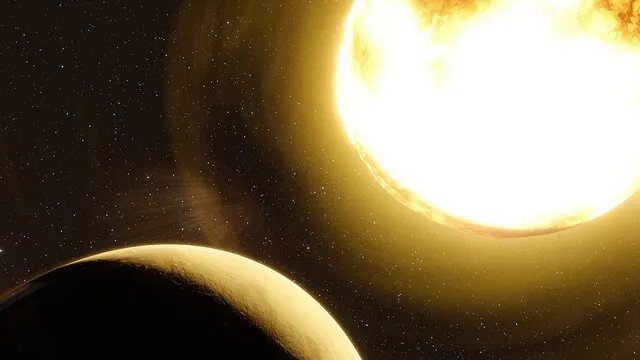A Groundbreaking Discovery
Scientists have officially confirmed the discovery of a potentially habitable exoplanet located just 30 light-years away from Earth. This incredible finding has sparked excitement in the scientific community and raised new questions about the possibility of extraterrestrial life.

What Makes This Discovery Important?
The search for habitable planets has been ongoing for decades, but very few exoplanets meet the conditions necessary for life as we know it. This newly discovered planet stands out because:
- It lies in the habitable zone – meaning it is at the right distance from its star for liquid water to exist.
- It has an Earth-like size and composition – indicating that it may have a rocky surface, just like our planet.
- It orbits a stable star – providing favorable conditions for sustaining an atmosphere.
Key Details About the Exoplanet
1. Distance and Location
- The planet is located 30 light-years away, which is relatively close in cosmic terms.
- It orbits a red dwarf star, which is smaller and cooler than our Sun.
- Red dwarf stars are known for their long lifespans, which increases the potential for stable conditions over billions of years.
2. Size and Composition
- It is slightly larger than Earth, making it a super-Earth category planet.
- The presence of rocky terrain increases the likelihood of a solid surface where life could potentially thrive.
- Its mass suggests it has a strong gravitational pull, which could help maintain an atmosphere.

3. Atmospheric and Surface Conditions
- Scientists believe the planet may have an atmosphere capable of retaining heat.
- Water detection is still under study, but conditions suggest the possibility of oceans or lakes.
- The planet’s gravity is expected to be similar to Earth’s, making it more comfortable for potential life.
- If the planet has an atmosphere similar to Earth’s, it could have a breathable mix of gases, which would be a major breakthrough.
- The composition of the atmosphere will determine if the planet is truly habitable or if it harbors extreme conditions.
How Was This Planet Discovered?
The exoplanet was detected using the transit method and the radial velocity technique. These methods help scientists identify planets by:
- Observing dips in starlight when a planet passes in front of its star.
- Measuring slight wobbles in the star’s motion, caused by the planet’s gravitational pull.
- Using advanced telescopes, astronomers were able to gather data on its mass, orbit, and potential habitability.

Could This Planet Host Life?
1. Favorable Conditions
- Being in the habitable zone means temperatures could support liquid water, a key ingredient for life.
- A rocky surface and possible atmosphere increase the chances of habitability.
- Scientists suspect that if the planet has oceans or lakes, it might already host microbial life.
- Its distance from its star suggests that it could have a day-night cycle similar to Earth’s, which would further support life-friendly conditions.
2. Challenges and Unknowns
- The planet’s atmosphere needs further study – if it has too much carbon dioxide or other gases, it could be inhospitable.
- Cosmic radiation levels might be high due to the proximity to a red dwarf star.
- We don’t know if life exists there yet, but future missions could provide more answers.
- The planet may experience intense stellar flares from its host star, which could pose challenges for sustaining life.
What Happens Next? Future Space Missions
1. Advanced Telescopes and Observations
- NASA’s James Webb Space Telescope and other powerful observatories will examine the planet’s atmosphere for life-supporting elements like oxygen and methane.
- Ground-based telescopes will continue monitoring the planet’s orbit and conditions.
- Scientists will analyze data from multiple sources to confirm whether the planet’s conditions remain stable over time.

2. Possible Space Missions
- Future space missions could send robotic probes to explore the planet’s surface.
- Scientists are considering new space travel technologies that might allow us to reach such planets faster.
- Advances in propulsion systems, such as ion drives or nuclear propulsion, could make interstellar exploration a reality.
- Space agencies and private companies are collaborating to develop long-term space exploration projects, including potential missions to nearby exoplanets.
What This Means for Humanity
1. A Step Closer to Finding Life Beyond Earth
- This discovery fuels excitement about the possibility of alien life.
- If conditions are right, this could be the first known planet where humans might settle in the future.
- Understanding exoplanets like this one will help us refine our search for other potentially habitable worlds.
- The more we learn, the better equipped we will be to explore planets beyond our solar system.
2. Advancing Space Exploration
- Finding habitable planets strengthens the case for future space colonization.
- This motivates new investments in space research and technology.
- It pushes the boundaries of what we know about the universe and our place in it.
- It opens doors for international collaboration in space exploration and scientific discovery.
Conclusion
The discovery of a habitable exoplanet just 30 light-years away marks an exciting breakthrough in astronomy. While much remains to be studied, this planet brings us closer than ever to answering the age-old question: Are we alone in the universe? As technology advances, we may soon uncover even more details about this world and others like it. Who knows? In the future, humanity might set foot on this distant planet, making it our first true step into the stars.
Federal Student Loan Repayments Resume After Three-Year Pause: What Borrowers Need to Know






